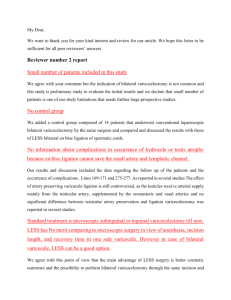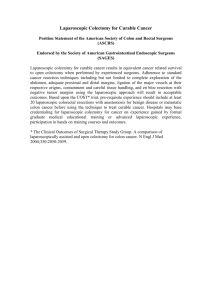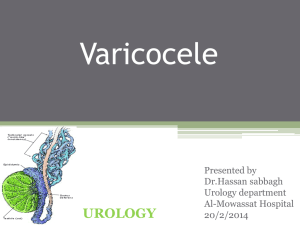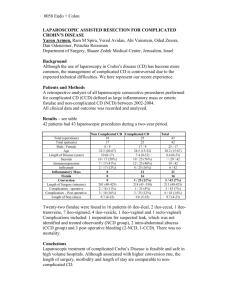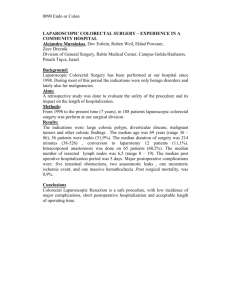Bilateral spermatic cord en bloc ligation by
advertisement
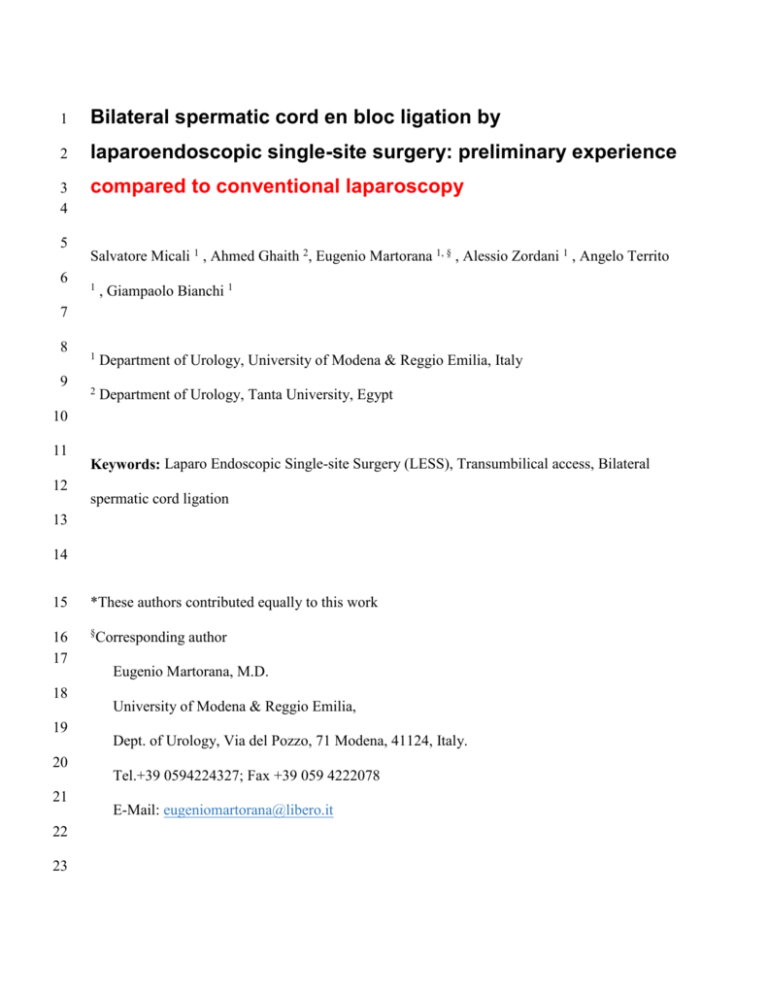
1 Bilateral spermatic cord en bloc ligation by 2 laparoendoscopic single-site surgery: preliminary experience 3 4 5 6 compared to conventional laparoscopy Salvatore Micali 1 , Ahmed Ghaith 2, Eugenio Martorana 1, § , Alessio Zordani 1 , Angelo Territo 1 , Giampaolo Bianchi 1 1 Department of Urology, University of Modena & Reggio Emilia, Italy 2 Department of Urology, Tanta University, Egypt 7 8 9 10 11 12 Keywords: Laparo Endoscopic Single-site Surgery (LESS), Transumbilical access, Bilateral spermatic cord ligation 13 14 15 *These authors contributed equally to this work 16 17 § 18 19 20 21 22 23 Corresponding author Eugenio Martorana, M.D. University of Modena & Reggio Emilia, Dept. of Urology, Via del Pozzo, 71 Modena, 41124, Italy. Tel.+39 0594224327; Fax +39 059 4222078 E-Mail: eugeniomartorana@libero.it 24 ABSTRACT 25 Background: Laparo Endoscopic Single-site Surgery (LESS) represents an evolution of 26 minimally invasive surgery and aims to improve cosmetic outcome and reduce surgical trauma 27 and complications associated with traditional laparoscopy. This study was performed to present 28 our preliminary experience in bilateral spermatic cord ligation with the LESS technique and 29 compare the results with the outcomes of conventional laparoscopic surgery. 30 Methods: Between June 2007 and May 2013, 24 patients were referred to our institute for 31 bilateral varicocelectomy. The indications for this type of procedure were bilateral varicocele 32 with impairment of semen parameters or chronic bilateral testicular pain. All procedures were 33 performed via the same surgeon. The patients were divided into two groups according to the type 34 of laparoscopic surgery. Group A included 10 patients underwent LESS technique while group B 35 included the remaining 14 patients that underwent conventional laparoscopy. 36 Results: The comparison between the two techniques showed some important advantages for 37 LESS: shorter operating time (45.4 min vs. 88.3 (P < .001), shorter hospital stay (16.6 hours vs. 38 51.4 hours) (P < .001), early return to the normal activity (2.3 days vs. 4.7 days) and better 39 cosmetic outcomes. No conversions from LESS to conventional laparoscopy were necessary and 40 blood loss was insignificant in all patients. 41 All patients in the LESS group reported full satisfaction with the cosmetic outcome (Fig. 5), 42 whereas 85.7% of patients after conventional laparoscopy were fully satisfied with cosmesis. 43 Conclusions: Bilateral spermatic cord ligation with LESS is an alternative to conventional 44 laparoscopy. The procedure was successfully performed in all patients. The trans-umbilical 45 approach offers the advantage of a better cosmetic result, shorter hospital stay and less 46 postoperative pain. 47 Backgroud 48 The prevalence of varicocele is approximately 15% to 20% in the general male population and it 49 increases to 40% to 70% in men with primary and secondary infertility, thus making varicocele 50 the most common correctable male infertility factor [1]. Less frequently, varicocele may be a 51 source of chronic testicular pain. 52 There are several theories regarding the mechanism by which varicocele could inhibit the 53 fertility potential of affected men. The most commonly proposed theory is that excess heat, due 54 to the varicocele, reduces spermatogenesis. Some have also speculated that the effect is via 55 reflux of metabolites into the testes [2,3]. 56 Various treatment modalities have been studied for patients with varicocele who have subfertility 57 or scrotal pain, including percutaneous embolization, open (inguinal or high) varicocele ligation, 58 subinguinal microsurgical varicocele ligation, and laparoscopic varicocele ligation. Each 59 technique has advantages and disadvantages, and conflicting results have been achieved in 60 different studies [4]. Advantages of laparoscopic varicocelectomy include: - increased 61 magnification, facilitating more accurate identification of vessels [5,6]. Also, laparoscopic 62 varicocelectomy allows for en bloc and bilateral ligation of the spermatic cord. 63 Efforts to further reduce the morbidity and improve the cosmetic outcome of laparoscopic 64 surgery have led to the evolution of Laparo-Endoscopic Single-site Surgery (LESS) [7]. LESS 65 has been developed in an attempt to reduce the morbidity and multiple scarring associated with 66 laparoscopic surgery [8]. The feasibility of LESS varicocelectomy as a treatment modality has 67 been described [9]. 68 In this study we present our preliminary experience of bilateral en bloc spermatic cord ligation 69 with LESS technique and compare the results with the outcomes of conventional laparoscopic 70 surgery. 71 72 73 74 75 76 77 78 79 80 81 82 83 84 85 86 87 88 89 90 91 Methods 92 Patient Demographics 93 Between June 2007 and May 2013, 24 patients were referred to our institute for bilateral 94 varicocelectomy. The indications for this type of procedure were bilateral varicocele with 95 impairment of semen parameters or chronic bilateral testicular pain, based on physical 96 examination, semen analysis and Doppler ultrasonography. Bilateral varicocelectomy in our 97 institute is a part of routine/standard care whether open or laparoscopic. All patients gave written 98 informed consent for the technique. The patients were divided into two groups according to the 99 type of laparoscopic surgery and the data was collected retrospectively. 100 Group A included 10 patients that underwent bilateral LESS en bloc spermatic cord ligation. 101 Their age ranged from 24 to 44 years old (mean age: 30.2 years). Two cases were bilateral grade 102 2, one case was grade 4 on the left and grade 2 on the right side, one case was grade 3 on the left 103 and grade 2 on the right side, and six cases were bilateral grade 3. Two of these patients had 104 recurrence after previous left open varicocelectomy. One patient had chronic testicular pain 105 [Table1]. 106 Group B included the remaining 14 patients that underwent bilateral varicocelectomy using 107 conventional laparoscopy. The age ranged from 17 to 42 years old (mean age: 29.3 years), two 108 cases were bilateral grade 3, four cases were bilateral grade 2, one case was bilateral grade 1, 109 four cases were left grade 2 and right grade 1, two cases were left grade 3 and right grade 2 and 110 one was left grade 4 and right 2. Three of these patients had recurrence after previous left open 111 varicocelectomy. Two patients had chronic testicular pain [Table 2]. 112 113 Transabdomenal sonography was done in all cases to exclude retroperitoneal masses and 114 preoperative semen analysis was performed in all patients. Exclusion criteria included patients 115 who underwent previous abdominal surgery. All patients provided informed consent. 116 All procedures were performed in the Urology Department of the University of Modena and 117 Reggio Emilia, Italy. Laparoscopic and LESS varicocelectomies were performed by an 118 individual urologist who was skilled in and experienced with laparoscopic surgery using a 119 standardized protocol. 120 121 Operative Technique 122 After insufflation with carbon dioxide at 15 mmHg, the procedure started with 2 cm incision on 123 the lower margin of the umbilicus (Figure 1). In the first five cases our transperitoneal access 124 was created with the aid of 10 mm optical laparoscopic visual reusable trocar, Ternamian 125 EndoTIP 10 mm (Karl Storz®, Tuttlingen, Germany) (Figure 2). This trocar enabled dissection of 126 each tissue layer under direct vision, so that the surgeon has the visual control needed to avoid 127 blood vessels. The next step was to substitute the optical trocar with a disposable multiport trocar 128 (Covidien SILS™ Port, Mansfield, MA, USA) (Figure 3). 129 In the next five cases we performed an open technique to access the abdominal cavity and 130 position the SILS port. Trans-umbilical access has two advantages: the use a pre-existing scar 131 gives better cosmetic result, and trans-umbilical access allows for quick identification of the 132 spermatic cords and vas deferens bilaterally by the same incision. The SILS port allows the 133 insertion of a 5-mm flexible laparoscope EndoEye camera system (Olympus Medical, 134 Orangeburg, NY, USA) that minimizes the internal and external clashing of the instruments (Fig. 135 4). Standard, reusable, 5 and 10 mm laparoscopic instruments were used to perform the 136 procedure. 137 A 3- 4 cm “T” incision of the posterior parietal peritoneum was done lateral to the spermatic 138 cord and proximal to the internal ring and vas deferens. The spermatic cord was isolated en bloc 139 and four Hem-o-lok® (Teleflex Medical Research, Triangle Park, NC, USA) were placed for 140 haemostasis. It is important to ensure vas deferens preservation with its artery to ensure blood 141 supply to the ipsilateral testis. The same manoeuvre was then performed on the other side. At the 142 end of the procedure the abdominal cavity is slowly deflated for haemostasis control. 143 144 Conventional laparoscopic varicocelectomy 145 The surgical steps were identical to those described for LESS technique. Under general 146 anesthesia the patient is positioned supine and a Foley catheter is placed in the bladder. The 147 abdomen is insufflated to 15 mm. Hg and a 12 mm transumbilical optical trocar was used for the 148 0-degree lens. A second 5 mm. port and an additional 10 mm. port were placed in the mid line 149 of lower abdomen between umbilicus and symphysis pubis and used for dissection using 150 standard, reusable, 5 and 10 mm laparoscopic instruments. 151 The overlying peritoneum is incised and the spermatic cord is isolated circumferentially 152 proximal to the internal inguinal ring and the vas deferens. 153 Selective bilateral varicocelectomy was performed in 5 cases. Gonadal vein is identified and 154 adjacent tissue with lymphatics is swept away, and the vein is ligated using titanium clips. The 155 papaverine test is used for identification and preservation of the testicular artery. En bloc ligation 156 of the spermatic cord and surrounding tissue was performed in the remaining 9 cases using Hem- 157 o-lok®. 158 159 160 Results 161 All procedures were performed successfully. Table 3 summarizes the results of both groups. 162 In LESS group operative time ranged from 31 to 75 minutes (mean: 45.4 minutes), and the 163 estimated blood loss was insignificant. The hospital stay ranged from 12 to 24 hours (mean: 16.6 164 hours). Time to return to work ranged from 2 to 3 days (mean: 2.3 days). None of the patients 165 required narcotics or additional analgesia in the postoperative period. No intraoperative nor 166 postoperative complications occurred. 167 In conventional laparoscopy group operative time ranged from 65 to 130 minutes (mean: 88.3 168 minutes), and the estimated blood loss was insignificant. The hospital stay ranged from 24 to 168 169 hours (mean: 51.4 hours). Time to return to work ranged from 4 to 7 days (mean: 4.7 days). Five 170 patients required postoperative analgesia. Two patients had lefts orchitis and one of these 171 developed an abdominal hematoma. 172 A scrotal echo-color Doppler was performed after 3, 6 and 12 months in all patients of both 173 groups and showed no recurrence of varicocele, no testicular hypotrophy nor secondary 174 hydrocele developed in any patients. A postoperative semen analysis was done 3, 6 and 12 175 months post-procedure to evaluate the sperm concentration, motility, and morphology; it showed 176 an improvement of semen parameters in seven of LESS group patients versus nine patients of the 177 other group. The patients with chronic testicular pain in both groups had improvement after 3 178 months. Six months after the procedure, the patients were completely pain free. 179 All patients in the LESS group reported full satisfaction with the cosmetic outcome (Fig. 5), 180 whereas 85.7% of patients after conventional laparoscopy were fully satisfied with cosmesis. 181 The comparison between the two techniques showed some important advantages for LESS: 182 shorter operating time (45.4 min vs. 88.3 (P < .001), shorter hospital stay (16.6 hours vs. 51.4 183 hours) (P < .001), early return to the normal activity (2.3 days vs. 4.7 days) and better cosmetic 184 outcomes. No conversions from LESS to conventional laparoscopy were necessary and blood 185 loss was insignificant in all patients. 186 187 188 189 190 191 192 193 194 195 196 197 198 199 200 201 202 203 204 205 206 Discussion 207 Varicocele is considered one of the most important causes of male infertility and prepubertal 208 testicular hypotrophy. The most common indications for varicocelectomy are subfertility and 209 chronic orchialgia [10,11]. Many clinical trials report a beneficial effect of varicocele repair on 210 male reproduction with improvement in semen parameters, but some show the contrary [12]. 211 The ideal method of varicocele treatment is a controversial issue. Several methods have been 212 used, including open surgical ligation of the spermatic vein, retrograde or antegrade 213 sclerotherapy, and laparoscopic and microsurgical varicocelectomy. Each technique has 214 advantages and disadvantages, and conflicting results have been achieved in different studies 215 [13]. 216 The role of laparoscopic varicocelectomy is still controversial. According to our experience, the 217 laparoscopic approach should be considered mostly in patients requiring bilateral 218 varicocelectomy, since it appears to be a sensible alternative to 2 groin incisions. Also 219 laparoscopic approach has short operative time and offers an easier postoperative course. 220 LESS has been developed in an attempt to further reduce the multiple ports morbidities and 221 scarring associated with laparoscopic surgery [8]. In many studies, LESS varicocelectomy was 222 reported to have acceptable feasibility, high patient satisfaction, and good postoperative 223 outcomes [9,14-17]. Our study is in correspondence with these previous studies. It demonstrates 224 that bilateral LESS varicocele ligation provides the best results comparison with those of the 225 conventional laparoscopic technique. 226 The mean operative time was shorter in LESS group than in conventional laparoscopic group 227 (45.4 minutes vs 88.3 minutes). The longer operative time in conventional laparoscopy group 228 may be related to multiple numbers of access and performance of selective varicocelectomy in 5 229 of these patients. Dong Hyuk Kang et al, compared postoperative outcomes in patients treated 230 with selective and non-selective LESS varicocele ligation. Mean operative time in non-selective 231 group was similar to ours (48.6 minutes) while the mean operative time of selective group is 232 shorter than that we found in conventional laparoscopy (60.7 minutes) [18]. This finding clarifies 233 that the longer operative time in conventional laparoscopy may be related principally to multiple 234 numbers of access. 235 The benefits of minimally invasive surgery are well recognized and include shorter length of 236 stay, less analgesic requirement, faster convalescence, and better cosmetic outcomes. LESS is 237 emerged to encounter these advantages. Our study showed that hospital stay and return to work 238 were shorter in LESS group (16.6 hours vs 51.4 hours and 2.3 days vs 4.7 days respectively). 239 We used an optical trocar to do transperitoneal access in the first five cases but, we found that it 240 makes a false subcutaneous plain, as it has a smooth end and the subcutaneous fascia at the 241 umbilicus is tough. This optical trocar technique prolonged operative time, and as a result we 242 decided to directly perform open access to enter the abdominal cavity in the remaining five 243 cases. 244 In our experience, using Covidien SILS™ Port gives many advantages. It is an excellent device 245 that can be handled easily. It is composed of two parts, a sponge cork and three trocars. The 246 sponge cork will seal the skin incision and the trocars prevent CO2 leakage which is considered 247 as an advantage over a gel port, which usually leaks. The optic with which we have obtained the 248 best results is the 5-mm flexible laparoscope EndoEye camera system (Olympus Medical). This 249 device provides flexibility and better working conditions [19]. In our experience we placed the 250 instruments on different levels in the space with camera; with this expedient, the contact or 251 clashing of instruments and the camera during LESS can be avoided. 252 Using transumbilical access, in LESS varicocelectomy, which is a pre-existing scar has potential 253 better cosmetic outcomes and patient’s satisfaction. Also, it allows for bilateral en bloc ligation 254 of the spermatic cord through the same access. 255 All patients underwent LESS vaicocelectomy showed better cosmetic outcomes and were very 256 satisfied while 85.7% of patients underwent conventional laparoscopy were very satisfied by 257 cosmetic outcomes. 258 All patients who underwent LESS varicocelectomy in our study did not need postoperative 259 analgesia while postoperative NSAIDs were used in 35.7% of patients underwent conventional 260 laparoscopy. This corresponds with the results of Xue et al. who performed a prospective, 261 randomized study comparing LESS with conventional laparoscopic varicocele ligation. They 262 reported that the visual analog scale (VAS) pain score was significantly lower 6 and 24 hours 263 after surgery in patients who underwent LESS [20]. 264 Our principle is en bloc ligation of the spermatic cord proximal to the internal inguinal ring via 265 LESS technique for treatment of patients with varicocele to preserve the distal gonadal artery 266 flow via collaterals from the proximal deferential artery. The effect of artery preserving 267 varicocele ligation is still controversial, as the testicles receive arterial supply mainly from the 268 testicular artery, supplemented by the cremasteric and vasal arteries [21]. 269 The division of the spermatic vessels for difficult orchiopexy was suggested by Bevan in 1903. 270 Later, Fowler and Stephens described the anatomy that allowed division of the spermatic vessels 271 to gain additional length and bring the testis to the scrotum while maintaining collateral blood 272 supply [22,23]. Yamamoto et al. compared the two surgical methods and found no significant 273 difference between testicular artery preservation and ligation varicocelectomy regarding semen 274 quality, pregnancy rates, or testicular volume [24]. 275 The retroperitoneal en bloc high ligation of a varicocele has the advantage of a lower incidence 276 of recurrence due to ligation of the entire spermatic cord, including the artery and periarterial 277 plexus of fine veins (venae comitantes), which may present as the source of recurrence [25]. 278 The results of these studies correspond with our results. All patients included in both groups 279 performed scrotal Doppler US at 3, 6, and 12 months and showed no recurrence of varicocele, no 280 postoperative testicular atrophy nor secondary hydrocele. 281 In contrast, Zampieri et al. found that those with artery- sparing had better postoperative semen 282 parameters than those who had undergone en bloc ligation that included the artery [26]. Raman 283 and Goldstein also recommended preserving the testicular arteries for optimal testicular blood 284 flow. However, prior series have revealed increased recurrence using the artery sparing method 285 vs. taking the artery and veins [27,28]. 286 The limitations of our study are the relatively small number of patients. Large randomized 287 prospective trials are required. 288 289 290 291 292 293 294 295 296 297 298 Conclusion 299 LESS is an effective technique for various urology indications. LESS en bloc bilateral spermatic 300 cord ligation is safe, effective, and showed good results in terms of intraoperative outcomes, 301 postoperative improvement in pain and semen parameters, and patient satisfaction, with no major 302 complications. Minimal hospitalization requirement following LESS spermatic cord ligation is 303 an additional timely advantage over conventional laparoscopic and open surgeries. 304 305 306 307 308 309 310 311 312 313 314 315 316 317 318 319 320 321 Abbreviations 322 VAS: Visual Analog Scale 323 LESS: Laparo Endoscopic Single site Surgery 324 325 Competing interest 326 All authors declare that they have no competing interest. 327 328 Authors’’ contributions 329 Eugenio Martorana and Ahmed Ghaith had full access to all the data in the study and take 330 responsability for the integrity of the data and the accuracy of the data analysis. 331 Salvatore Micali , Ahmed Ghaith, and Eugenio Martorana participated in study concept and 332 design. . 333 Ahmed Ghaith, and Eugenio Martorana participated in acquisition of data. 334 Ahmed Ghaith, and Eugenio Martorana participated in analysis and interpretation of data. 335 Ahmed Ghaith, and Eugenio Martorana participated in drafting of the manuscript. 336 Salvatore Micali and Giampaolo Bianchi participated in critical revision of the manuscript for 337 important intellectual content. 338 Eugenio Martorana, and Ahmed Ghaith participated in statistical analysis. 339 Salvatore Micali, Eugenio Martorana, Alessio Zordani, Angelo Territo participated in 340 administrative, technical, or material support. 341 Giampaolo Bianchi and Salvatore Micali participated in supervision of the manuscripy. 342 343 344 345 References 346 1. Witt MA and Lipshultz LI. Varicocele: a progressive or static lesion? Urology 1993; 42: 541. 347 2. Naughton CK, Nangia AK and Agarwal A. Pathophysiology of varicoceles in male 348 infertility. Hum Reprod Update 2001; 7: 473. 349 3. French DB, Desai NR and Agarwal A. Varicocele repair: does it still have a role in infertility 350 treatment? Curr Opin Obstet Gynecol 2008; 20: 269. 351 4. Mohammed A and Chinegwundoh F. Testicular varicocele: an overview. Urol Int 2009; 82: 352 373. 353 5. Glassberg KI, Poon SA, Gjertson CK, DeCastro GJ, Misseri R. Laparoscopic lymphatic 354 sparing varicocelectomy in adolescents. J Urol 2008; 180: 326–31. 355 6. Kocvara R, Dvorácek J, Sedlácek J, Díte Z, Novák K. Lymphatic sparing laparoscopic 356 varicocelectomy: a microsurgical repair. J Urol 2005; 173:1751–4. 357 7. Gill IS, Advincula AP, Aron M, et al. Consensus statement of the consortium for 358 laparoendoscopic single-site surgery. Surg Endosc 2010; 24: 762–768. 359 8. Autorino R, Cadeddu JA, Desai MM, et al. Laparoendoscopic singlesite and natural orifice 360 transluminal endoscopic surgery in urology: a critical analysis of the literature. Eur Urol 2011; 361 59: 26–45. 362 9. Kaouk JH, Palmer JS. Single-port laparoscopic surgery. Initial experience in children for 363 varicocelectomy. BJU Int 2008; 102: 97–9. 364 10. Cadeddu JA, Bishoff JT, Chan DY, Moore RG, Kavoussi LR, Jarrett TW. Laparoscopic 365 testicular denervation for chronic orchalgia. J Urol 1999; 162:733-5. 366 11. Brooks JD, Moore RG, Kavoussi LR. Laparoscopic management of testicular pain after 367 embolotherapy of varicocele. J Endourol 1994; 8 (5):361-3. 368 12. Ingrid Schauer, Stephan Madersbacher, Romy Jost, Wilhelm Alexander Hübner and Martin 369 Imhof. The Impact of Varicocelectomy on Sperm Parameters: A Meta-Analysis. J Urol 2011; 370 187, 1540-1547. 371 13. Sami Al-Said, Abdulla Al-Naimi, Abdulla Al-Ansari, Nagy Younis, Ahmed Shamsodini, 372 Khalid A-sadiq and Ahmed A. Shokeir. Varicocelectomy for Male Infertility: A Comparative 373 Study of Open, Laparoscopic and Microsurgical Approaches. J Urol 2008; Vol. 180, 266-270. 374 14. Riccardo Autorino, Jeffrey A. Cadeddu c, Mihir M. Desai d, Matthew Gettman e, Inderbir S. 375 Gill d, Louis R. Kavoussi f, Esteva˜o Lima g, Francesco Montorsi h, Lee Richstone f, Jens U. 376 Stolzenburg i, Jihad H. Kaouk. Laparoendoscopic Single-site and Natural Orifice Transluminal 377 Endoscopic Surgery in Urology: A Critical Analysis of the Literature. Eur Urol 2011; 59, 26-45. 378 15. Kaouk JH, Autorino R, Kim FJ et al. Laparoendoscopic single-site surgery in urology: 379 worldwide multi-institutional analysis of 1076 cases. Eur Urol 2011; 60: 998. 380 16. White WM, Haber GP, Goel RK et al. Single-port urological surgery: single-center 381 experience with the first 100 cases. Urology 2009; 74: 801. 382 17. Lee SW, Lee JY, Kim KH et al. Laparoendoscopic single-site surgery versus conventional 383 laparoscopic varicocele ligation in men with palpable varicocele: a randomized, clinical study. 384 Surg Endosc 2012; 26: 1056. 385 18. Dong Hyuk Kang, Joo Yong Lee, Jae Hoon Chung et al. Laparoendoscopic Single Site 386 Varicocele Ligation: Comparison of Testicular Artery and Lymphatic Preservation Versus 387 Complete Testicular Vessel Ligation. J Urol 2013; 243:249. 388 19. Autorino R, Cadeddu JA, Desai MM, et al. Laparoendoscopic singlesite and natural orifice 389 transluminal endoscopic surgery in urology: a critical analysis of the literature. Eur Urol 2011; 390 59: 26–45. 391 20. Riccardo Autorino, Jeffrey A. Cadeddu c, Mihir M. Desai d, Matthew Gettman e, Inderbir S. 392 Gill d, Louis R. Kavoussi f, Esteva˜o Lima g, Francesco Montorsi h, Lee Richstone f, Jens U. 393 Stolzenburg i, Jihad H. Kaouk. Laparoendoscopic Single-site and Natural Orifice Transluminal 394 Endoscopic Surgery in Urology: A Critical Analysis of the Literature. Eur Urol 2011; 59, 26-45. 395 21. Mostafa T, Labib I, El-Khayat Y et al. Human testicular arterial supply: gross anatomy, 396 corrosion cast, and radiologic study. Fertil Steril 2008; 90: 2226. 397 22. Bevan, A. D. The surgical treatment of undescended testis: a further contribution. J.A.M.A. 398 1903; 41: 718. 399 23. Fowler, R. and Stephens, F. D. The role of testicular vascular anatomy in the salvage of high 400 undescended testis. Aust. New Zeal. J. Surg 1959; 29, 92. 401 24. Yamamoto M, Tsuji Y, Ohmura M et al. Comparison of artery-ligating and artery- reserving 402 varicocelectomy: effect on post-operative spermatogenesis. Andrologia 1995; 27: 37. 403 25. Hopps CV, Goldstein M. Varicocele. Unified theory of pathophysiology and treatment. AUA 404 Update Series 2004; 23: lesson 12. 405 26. Zampieri N, Zuin V, Corroppolo M, Chironi C, Cervellione RM and Camoglio FS. 406 Varicocele and adolescents: semen quality after 2 different laparoscopic procedures. J Androl 407 2007; 28: 727. 408 27. Raman JD and Goldstein M. Intraoperative characterization of arterial vasculature in 409 spermatic cord. Urology 2004; 64: 561. 410 28. Kass EJ and Marcol B. Results of varicocele surgery in adolescents: a comparison of 411 techniques. J Urol 1992; 148: 694. 412 413 414 Tables 415 Table 1. LESS group Patients’ Characteristics Patient Name Age Varicocele grade Previous varicocelectomy 1 MG 24 Grade 4 on the left, grade 2 on the No right side 2 GD 29 Bilateral grade 2 No 3 MM 29 Bilateral grade 3 No 4 AM 30 Bilateral grade 2 No 5 PC 31 Bilateral grade 3 No 6 LU 25 Bilateral grade 3 Left varicocelectomy 7 MS 44 Bilateral grade 3 with chronic Left varicocelectomy testicular pain 8 AG 32 Bilateral grade 3 No 9 EM 30 Bilateral grade 3 No 10 SM 28 Grade 3 on the left and grade 2 on the No right 416 417 418 419 420 421 422 Table 2. Conventional laparoscopy group Patients’ Characteristics No. Name Age Varicocele grade Previous varicocelectomy 1 PL 20 Bilateral grade 2 No 2 PS 41 Left grade 4 Left varicocelectomy Right grade 2 3 GM 22 Left grade 3 No Right grade 2 4 YO 30 Left grade 2 Left varicocelectomy Right grade 1 5 YS 18 Bilateral grade 2 No 6 AA 19 Left grade 3 No Right grade 2 7 DS 17 Bilateral grade 2 No 8 TT 42 Bilateral grade 2 No 9 PS 30 Left grade 2 No Right grade 1 10 RD 41 Left grade 2 No Right grade 1 11 MA 20 Bilateral grade 3 No 12 RP 38 Left grade 2 Left varicocelectomy Right grade 1 423 13 AM 39 Bilateral grade 1 No 14 BC 33 Bilateral grade 3 No Table 3. Results LESS varicoselectomy Convention laparoscopic varicocelectomy Number of patients 10 14 Mean operative time 45.4 minutes 88.3 minutes Mean blood loss < 30 ml < 30 ml Mean hospital stay 16.6 hours 51.4 hours Postoperative analgesia 0 5 patients Mean time return to 2.3 days 4.7 days Non selective 5 patients: selective work Technique 9 patients: non-selective Complications 424 425 426 427 428 429 No 2 patients 430 431 432 433
